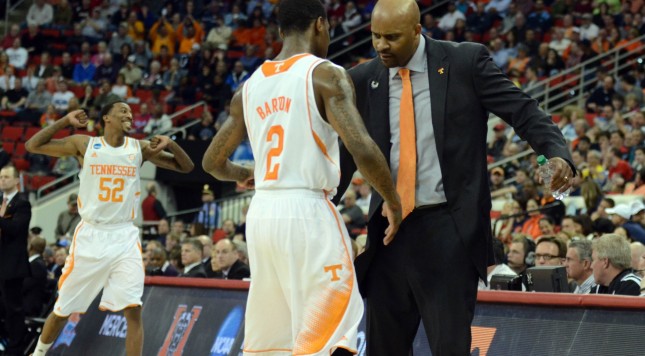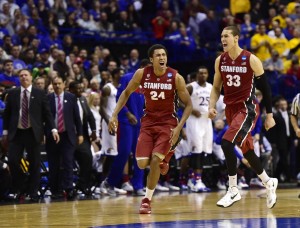On the surface of things, it would seem that it’s easier to make conference strength arguments (and comparisons) in college basketball than in college football.
Upon further reflection and examination… the statement probably retains a core measure of truth. The extent to which the statement is true (and that’s an opinion, of course, not a fact…) should represent the bigger debate.
Conference strength is easier to identify in college basketball because the sample size offered by the season is larger than in football. In college basketball, a lot more high-end teams from different conferences actually (get this!) play each other. There are more points of comparison. Yet, the constraining reality of a single-elimination tournament with bracket-altered matchups makes the NCAA tournament a valid yet eternally thorny basis for assessing conferences (and the coaches within them; we’re addressing coaching legacies and reputations in other articles this week at Run The Floor).
How do you find a reasonable way of judging conferences when tournament performance veers from regular season performance? The answer is subtly simple: You balance the two.
The more complex and layered response: You try to see if the gap between the regular season and the tournament is profound and — if so — rooted in a basketball version of “natural causes,” as opposed to suspensions (think of Fab Melo with Syracuse in 2012), injuries (Kenyon Martin with Cincinnati in 2000), or busted brackets (Baylor not playing any single-digit seed en route to the Elite Eight in both 2010 and 2012; Arkansas, as a 4 seed, not having to play any seed higher than 8 en route to the 1990 Final Four).
If you go through various NCAA tournament surprises from the first weekend, you can carry out this logical exercise and reach at least some measured conclusions about each league. The easiest yet most controversial case study to be found in the 2013-2014 season (and how the NCAA tournament has differed from the regular season) is the Southeastern Conference. There’s a reason Florida — a legitimately great team independent of its league, in much the same way that Memphis was great independent of Conference USA once upon a time — went 21-0 in the SEC.
Kentucky and Tennessee went a combined 0-6 against Florida. Neither the Wildcats nor the Vols played anywhere near their levels of talent; in Kentucky’s case, all the good shooting and sharp playmaking you saw against Wichita State was largely missing from the long regular season. It surfaced occasionally, but in the absence of a single win over Florida, what did the Wildcats (and the Vols) have to offer in the way of achievements? Kentucky defeated Louisville and Tennessee crushed Virginia. Other than those conquests, there wasn’t much meat on the bone in terms of a resume for either team. Tennessee got swept by Texas A&M and stumbled elsewhere. Kentucky lost at home to Arkansas and at South Carolina while being less than imposing on the road in general.
Let’s say this about the SEC: If Kentucky and Tennessee had been able to beat Florida at least once in three tries apiece (twice total in six combined chances), it would be far, far easier to say that these tournament runs were a reflection of the teams seen all season, thereby buttressing the argument that the SEC was underrated. With the 0-6 bagel against Florida and the lack of a deep stack of non-conference wins, no, there’s simply no credible argument to make that the SEC was underrated during the season. Kentucky and Tennessee are on “hot runs,” and that’s simply part of March Madness. Tennessee, moreover, avoided playing Duke in the round of 32.
A tougher case study lies in the Pac-12.
UCLA and Stanford have played their best basketball in March, much like Kentucky and Tennessee. UCLA, though, beat the king of its conference (Arizona), and Stanford grabbed a road non-conference win at Connecticut while winning games against the other NCAA tournament teams in the Pac-12. There was and is some evidence — not overpowering evidence, but some — to suggest that these teams showed Sweet 16-level chops at more than one or two points during the regular season.
- Stanford was almost out of the tournament… and now it’s a higher-seeded team in a Sweet 16 matchup with Dayton.
Moreover, UCLA was placed close to home and never had to play a seed higher than 12 in the first weekend of the Dance. Stanford did go through a much tougher path than UCLA to get to the Sweet 16, but the flip side is that Stanford came this close to not making the field of 68. Had it lost to Washington State in the first round of the Pac-12 Tournament, Stanford (which gained a 10 seed with a win over Arizona State in the Pac-12 quarterfinals; the result suggests that the Cardinal were an 11 or 12 seed before beating ASU) probably would have fallen below SMU to the NIT field.
It’s complicated like this after the first weekend of the tournament just about every year… such is the case with the Big 12 in 2014.
Kansas was Kansas during the conference season. The Jayhawks are great independent of their league… even though they lost to Stanford. (Remember the Joel Embiid injury in all this, too.) The true debate surrounding the Big 12 concerned the cluster of teams that finished tied for second in the league standings.
The Big 12, by most observers’ estimations, played better than every other league during the season, including the Big Ten, which was (by most estimations) down compared to 2013. Yet, in a dynamic that regularly emerges as college basketball seasons evolve, those teams tied for second place were examples of teams that maximized what they had during the season… but then were exposed as inferior when matched against good teams from other leagues. Texas, Oklahoma, Oklahoma State, Kansas State — the four teams that got eliminated during this past weekend — all had their profound flaws. Texas, OU, and Oklahoma State were all conspicuously porous on defense, and they bowed out in large part because they couldn’t get enough stops (OU because of a more complex combination of factors, but the larger critique is still valid). Kansas State’s weakness was much more simple: It couldn’t win away from its home arena. A clunker against Kentucky did nothing to change that reality.
You can therefore give the Big 12 credit for what it did during the season, and you can also note that Iowa State and Baylor were both very impressive (in different sorts of ways) this past weekend. Yet, in the absence of eye-popping regular season achievements, the idea that the league was “exposed” in March carries a certain degree of weight. The gap between the regular season and the NCAA tournament was, in these cases, enough to suggest that the Big 12 was overvalued. If you had your doubts about the Big 12 a week ago, those doubts were affirmed in the past 100 hours or so.
Conference comparisons are hard to make, and verdicts should not be overly broad… unless the evidence is overwhelming, as is the case with the ACC and, even more centrally, the Big East.
We’ll see what the upcoming regionals do to recalibrate the conference comparison discussion.
























